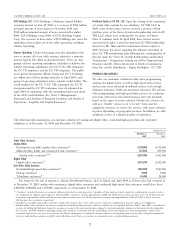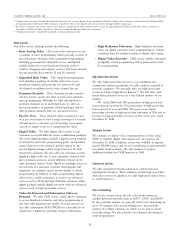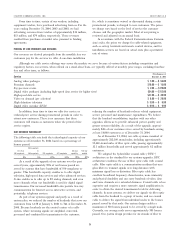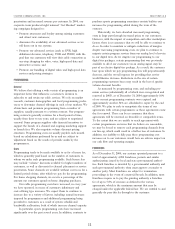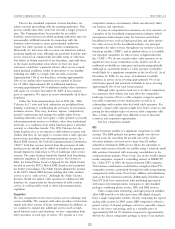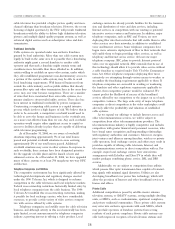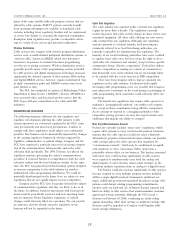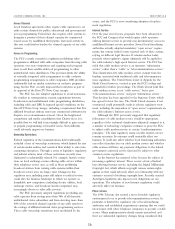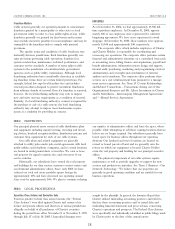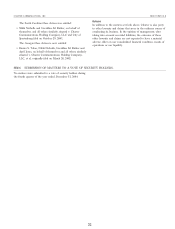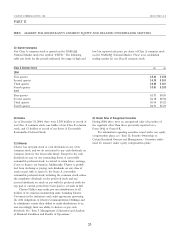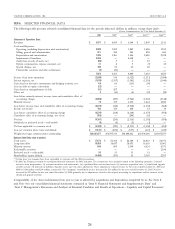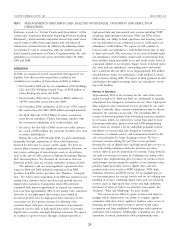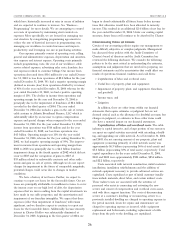Charter 2004 Annual Report Download - page 27
Download and view the complete annual report
Please find page 27 of the 2004 Charter annual report below. You can navigate through the pages in the report by either clicking on the pages listed below, or by using the keyword search tool below to find specific information within the annual report.
CHARTER COMMUNICATIONS, INC. 2004 FORM 10-K
could impact, in both positive and negative ways, our primary ‘‘broadcast flag’’ rules, requiring cable carriage of a code
telecommunications competitors and our own entry into the embedded in digital broadcast programming that will regulate
field of phone service. The FCC and state regulatory authorities the further use of copyright programming, although the FCC’s
are considering, for example, whether common carrier regula- jurisdiction to impose broadcast flag rules is currently being
tion traditionally applied to incumbent local exchange carriers challenged in court.
should be modified. The FCC recently decided that alternative The FCC is conducting additional related rulemakings, and
voice technologies, like certain types of VOIP, should be the cable and consumer electronics industries are currently
regulated only at the federal level, rather than by individual negotiating an agreement that would establish additional ‘‘plug
states. As the FCC generally does not favor extensive regulation and play’’ specifications for two-way digital televisions.
of such services, this decision appears to be a positive The FCC rules are subject to challenge and inter-industry
development for VOIP offerings. It is unclear how these negotiations are ongoing. It is unclear how this process will
regulatory matters ultimately will be resolved and how they will develop and how it will affect our offering of cable equipment
affect our potential expansion into phone service. and our relationship with our customers.
Pole Attachments Other Communications Act Provisions and FCC Regulatory Matters
The Communications Act requires most utilities to provide In addition to the Communications Act provisions and FCC
cable systems with access to poles and conduits and simultane- regulations noted above, there are other statutory provisions and
ously regulates the rates charged for this access. The Act FCC regulations affecting our business. The Communications
specifies that significantly higher rates apply if the cable plant is Act, for example, includes cable-specific privacy obligations. The
providing telecommunications service, as well as traditional Act carefully limits our ability to collect and disclose personal
cable service. The FCC has clarified that a cable operator’s information.
favorable pole rates are not endangered by the provision of FCC regulations include a variety of additional areas,
Internet access. Although that determination was upheld by the including, among other things: (1) equal employment opportu-
United States Supreme Court, a subsequent decision by the nity obligations; (2) customer service standards; (3) technical
United States Court of Appeals for the Ninth Circuit regarding service standards; (4) mandatory blackouts of certain network,
the proper regulatory classification of Internet service has once syndicated and sports programming; (5) restrictions on political
again created controversy in this area. The U.S. Supreme Court advertising; (6) restrictions on advertising in children’s program-
has agreed to hear an appeal of that decision. It remains ming; (7) restrictions on origination cablecasting; (8) restrictions
possible that the underlying pole attachment formula, or its on carriage of lottery programming; (9) sponsorship identifica-
application to Internet and telecommunications offerings, will be tion obligations; (10) closed captioning of video programming;
modified in a manner that substantially increases our pole (11) licensing of systems and facilities; and (12) maintenance of
attachment costs. public files; and (13) emergency alert systems.
It is possible that Congress or the FCC will expand or
Cable Equipment modify its regulation of cable systems in the future, and we
The FCC has undertaken several steps to promote competition cannot predict at this time how that might impact our business.
in the delivery of cable equipment and compatibility with new For example, there have been recent discussions about imposing
digital technology. The FCC has expressly ruled that cable ‘‘indecency’’ restrictions directly on cable programming.
customers must be allowed to purchase set-top terminals from
third parties and established a multi-year phase-in during which Copyright
security functions (which would remain in the operator’s Cable systems are subject to federal copyright licensing covering
exclusive control) would be unbundled from the basic converter carriage of television and radio broadcast signals. The possible
functions, which could then be provided by third party vendors. modification or elimination of this compulsory copyright license
The first phase of implementation has already passed. A is the subject of continuing legislative review and could
prohibition on cable operators leasing digital set-top terminals adversely affect our ability to obtain desired broadcast program-
that integrate security and basic navigation functions is currently ming. We cannot predict the outcome of this legislative activity.
scheduled to go into effect as of July 1, 2006, although the FCC Moreover, the Copyright Office has not yet provided any
may extend the deadline. guidance as to the how the compulsory copyright license should
The FCC has adopted rules implementing an agreement apply to newly offered digital broadcast signals.
between major cable operators and manufacturers of consumer Copyright clearances for non-broadcast programming ser-
electronics on ‘‘plug and play’’ specifications for one-way digital vices are arranged through private negotiations. Cable operators
televisions. The rules require cable operators to provide ‘‘Cable- also must obtain music rights for locally originated program-
Card’’ security modules and support to customer owned digital ming and advertising from the major music performing rights
televisions and similar devices already equipped with built-in set- organizations. These licensing fees have been the source of
top terminal functionality. Cable operators must support basic litigation in the past, and we cannot predict with certainty
home recording rights and copy protection rules for digital whether license fee disputes may arise in the future.
programming content. The FCC has adopted companion
17


